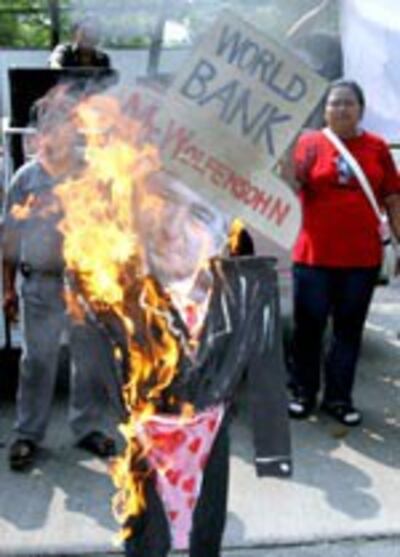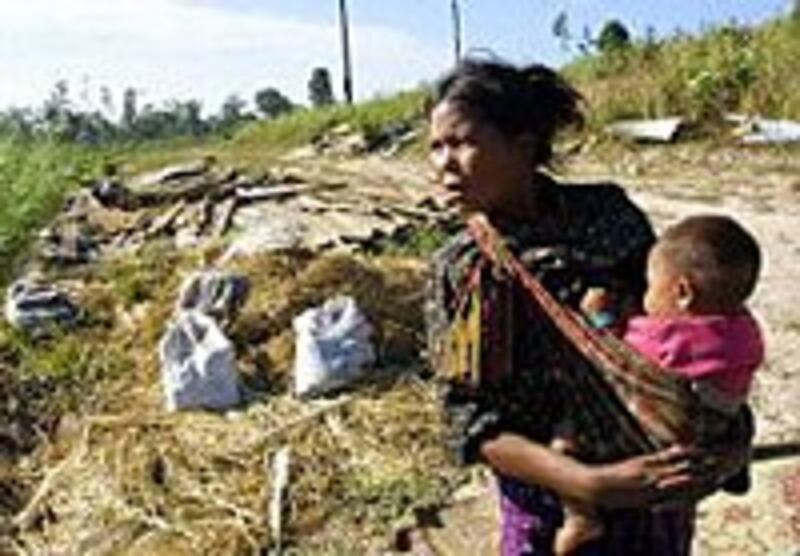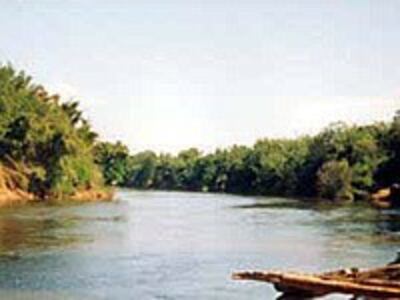
BANGKOK—Some 100 environmental activists and villagers have burned an effigy of World Bank President James Wolfensohn in the Thai capital, demanding that the bank scrap a controversial hydro-electric dam project in neighboring Laos.
"We are very concerned that the World Bank is now giving active support to another large dam project, Nam Theun 2, which, if built, will have countless negative impacts on both Laos and Thailand," a group of Thai farmers from the sites of other much-criticized Bank-funded dams in Thailand said in a statement.
The Pak Mun Dam and Lam Takhong irrigation scheme, two World Bank projects in northeast Thailand near Laos, devastated thriving fishing industries and left thousands of families without support, the farmers said.
"We know from experience... that the World Bank will finance projects and then avoid responsibility for the environmental problems they create."
Aviva Imhof, a U.S.-based activist from the International Rivers Network environmentalist group, charged that the project "is going to produce nothing but hardship for the affected people."
Wildlife could suffer
After nearly a decade of discussions and project preparation work, the World Bank this year begun its appraisal process for the so-called Nam Theun 2 dam.
We know from experience... that the World Bank will finance projects and then avoid responsibility for the environmental problems they create."
Thai conservationist groups have blasted the bank for failing to complete a wildlife assessment of the Nakai plateau watershed, site of the proposed dam, and for tying conservation funds to the project.
Thai NGO representative Virawat Thiraprasat added, "As somebody who monitors natural and environmental resources I can assure you that the Nam Theun 2 project would destroy wild animals in great numbers, just as we have witnessed [in the case of] the Thiewlaan Dam destroy enormous numbers of wild animals. The same might be happening in Laos."
The project is a venture between the government of Laos and the Nam Theun 2 Power Co., which comprises EDFI, the global arm of French state-owned Electricite de France, which holds a 35 percent stake.
"This project has been extensively studied for its social and environmental impacts," said Illangovan Patchamuthu, the World Bank's environmental affairs coordinator.
Construction could start soon
He said it includes plans for improving the welfare of those affected.
Construction of the Nam Theun 2 dam is set to begin if the World Bank's board of directors approves it next month. The protesters claimed it will ruin the lives of about 6,000 Laotian villagers who will be uprooted.

The dam would generate a large amount of electricity, 95 percent of which will be exported to Thailand, earning Laos a projected U.S. $200 million in annual revenue for 25 years.
Decision in May at latest
Vientiane says the income is needed to bring the country out of poverty.
The Bank announced in January it would move to appraise the project—in which private investors claim to have invested U.S.$40 million already.

"At this stage it would take a surprise or something unexpected to derail it," Peter Stephens, World Bank chief external officer for East Asia and the Pacific, told RFA.
A decision is widely expected by May at the latest, although Stephens said the Bank would take as long as it needed to make the appraisal.
The project is expected to displace around 6,200 indigenous people and affect more than 100,000 villagers who depend on the Xe Bang Fai River for their livelihood, according to research by NGOs.
